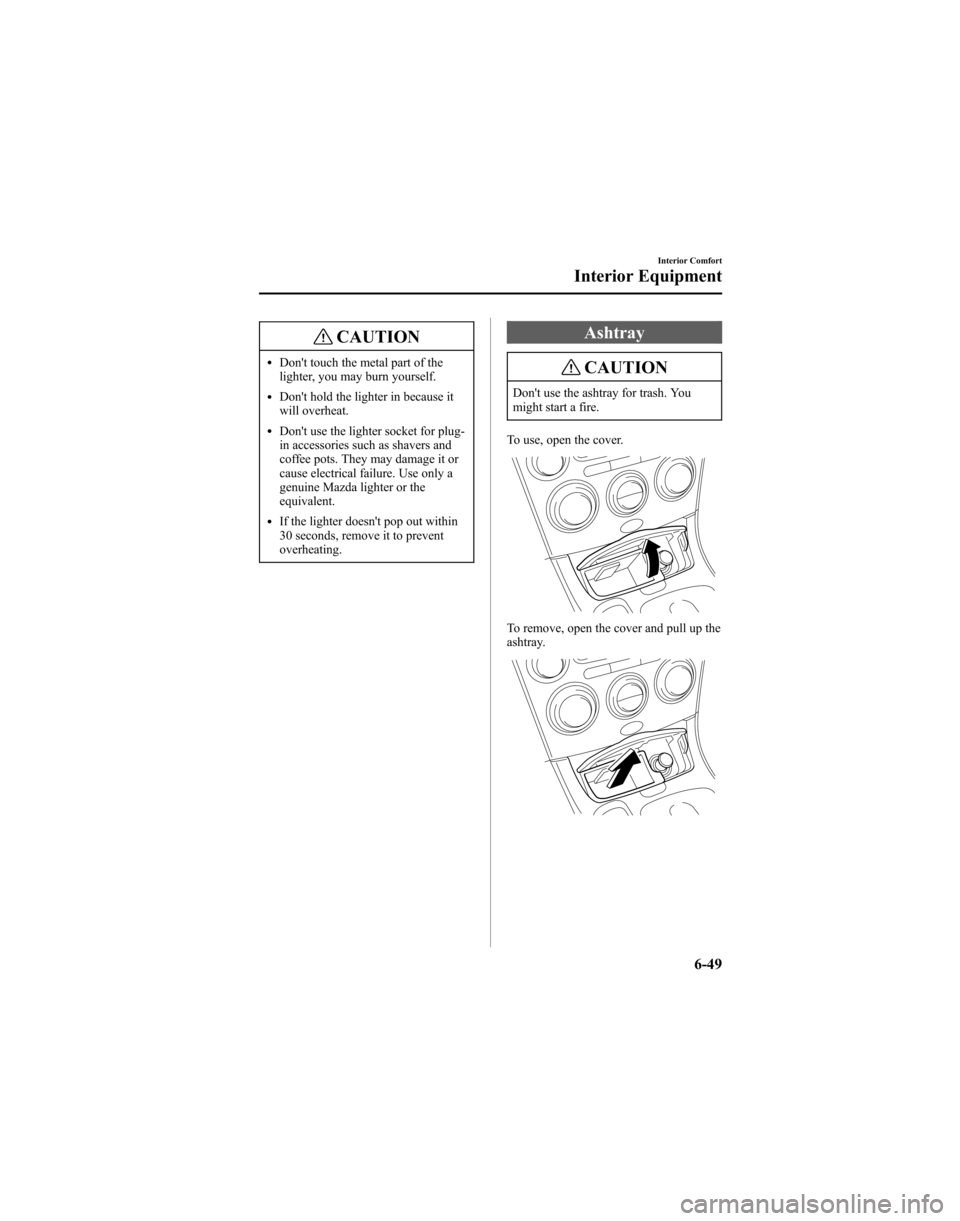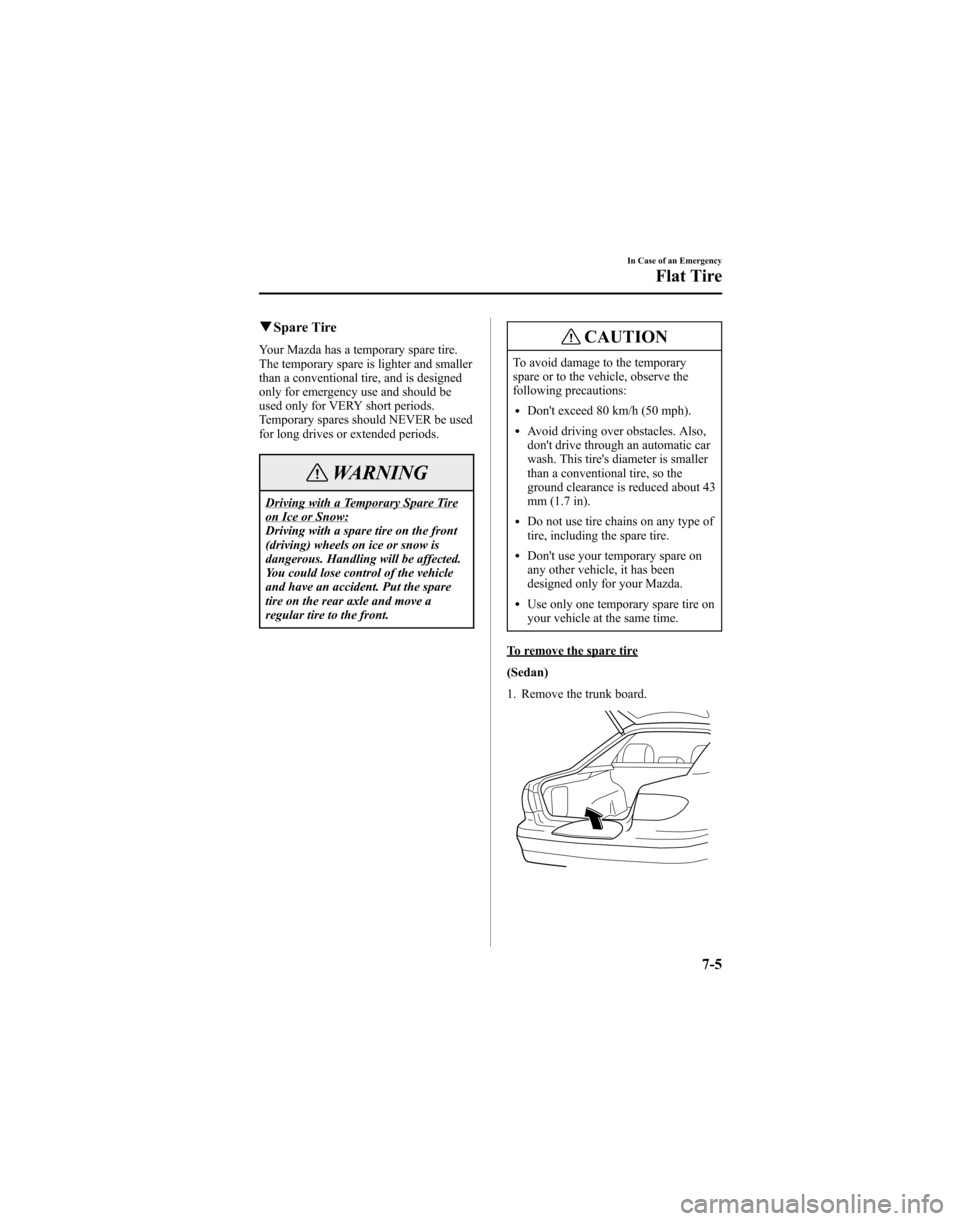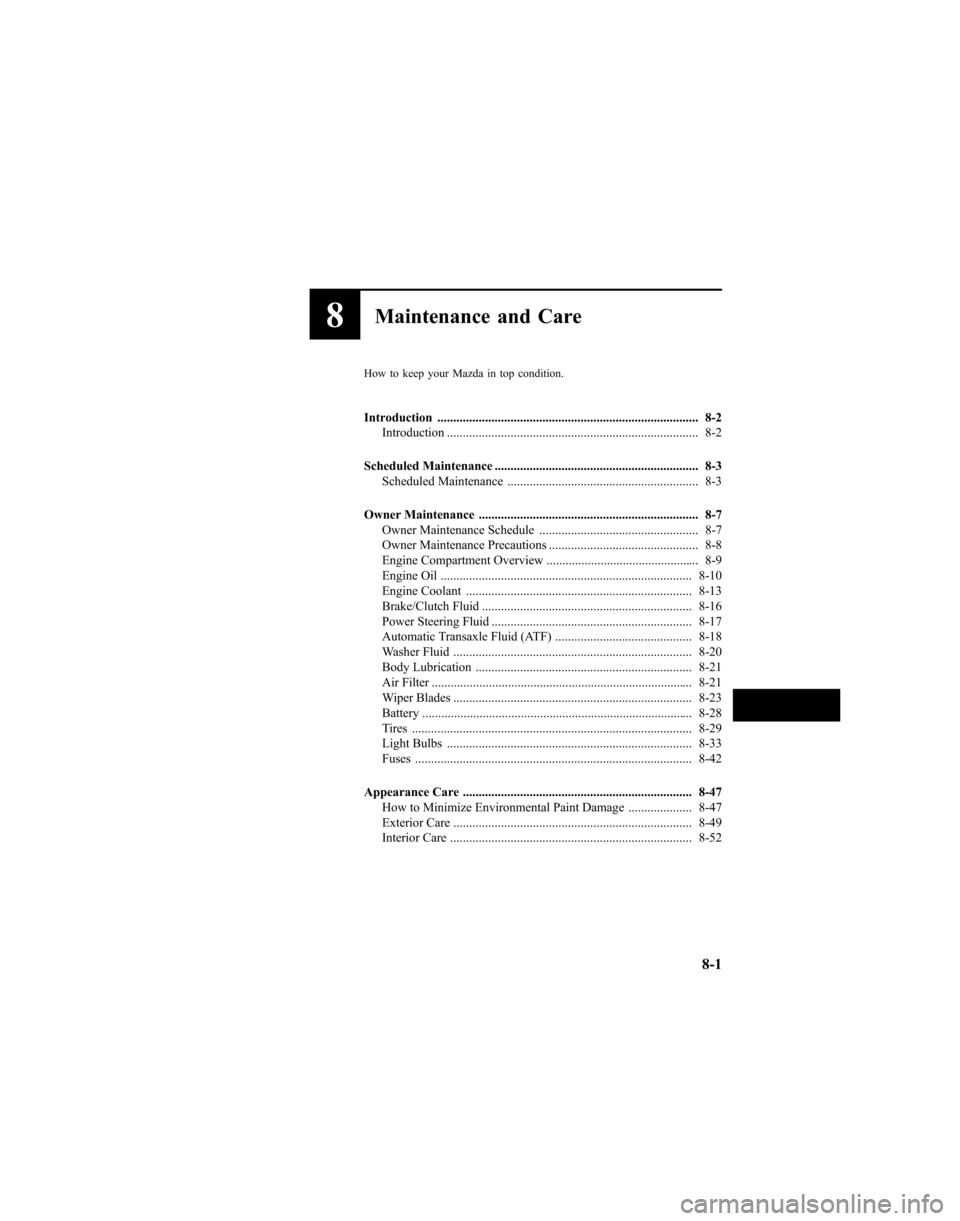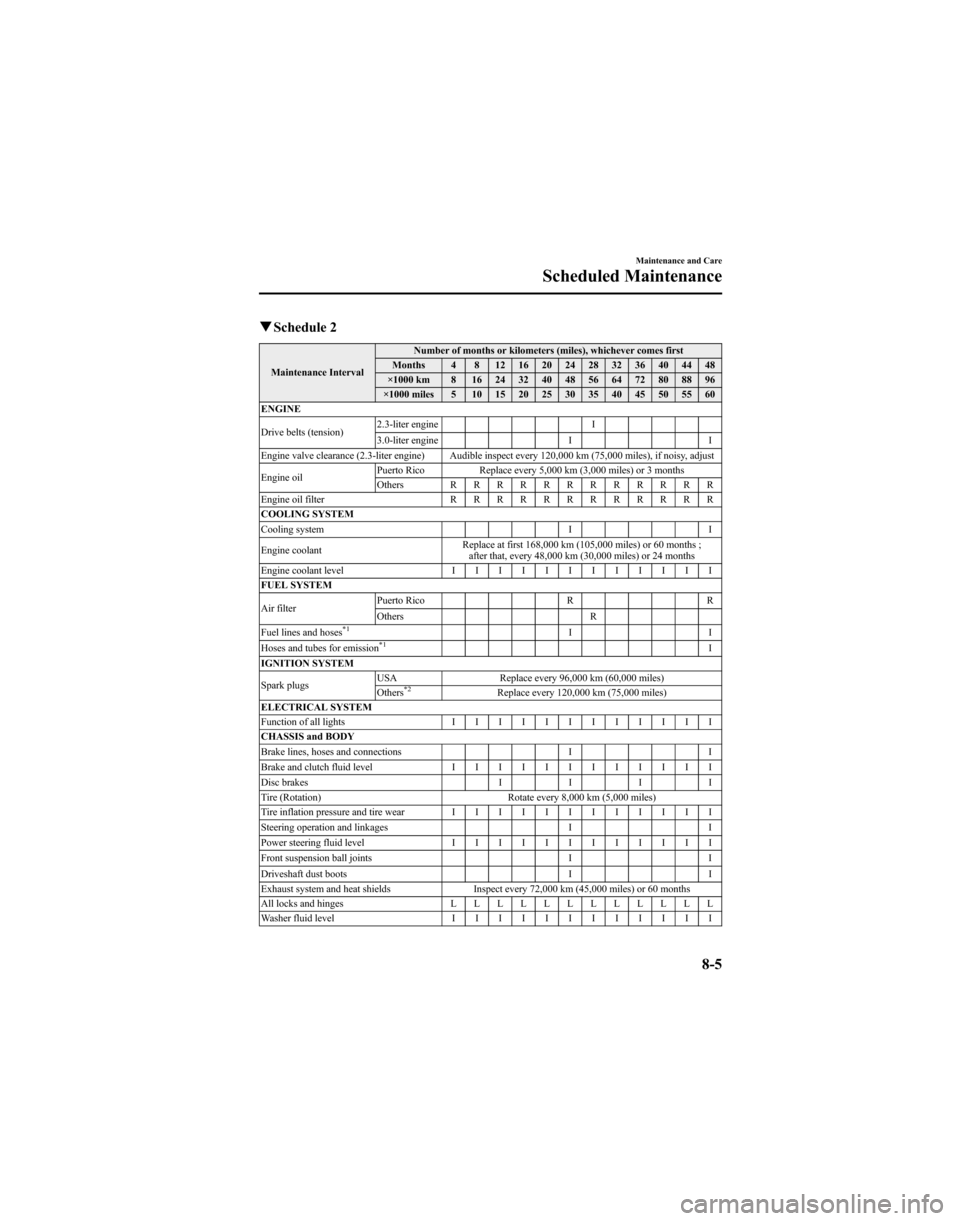light MAZDA MODEL 6 HATCHBACK 2005 Owners Manual (in English)
[x] Cancel search | Manufacturer: MAZDA, Model Year: 2005, Model line: MODEL 6 HATCHBACK, Model: MAZDA MODEL 6 HATCHBACK 2005Pages: 340, PDF Size: 3.08 MB
Page 221 of 340

CAUTION
lDon't touch the metal part of the
lighter, you may burn yourself.
lDon't hold the lighter in because it
will overheat.
lDon't use the lighter socket for plug-
in accessories such as shavers and
coffee pots. They may damage it or
cause electrical failure. Use only a
genuine Mazda lighter or the
equivalent.
lIf the lighter doesn't pop out within
30 seconds, remove it to prevent
overheating.
Ashtray
CAUTION
Don't use the ashtray for trash. You
might start a fire.
To use, open the cover.
To remove, open the cover and pull up the
ashtray.
Interior Comfort
Interior Equipment
6-49
Page 223 of 340

Bottle Holder
Bottle holders are on the inside of the
front doors.
Bottle holder
CAUTION
Don't use the bottle holders for
containers without caps. The contents
may spill when the door is opened or
closed.
Storage Compartments
WARNING
Open Storage Boxes:
Driving with the storage boxes open is
dangerous. To reduce the possibility of
injury in an accident or a sudden stop,
keep the storage boxes closed when
driving.
CAUTION
Don't leave eyeglasses or lighters in the
storage boxes while parked under the
sun. A lighter could explode or the
plastic material in eyeglasses could
deform and crack from high
temperature.
qOverhead Console
This console box is designed to store
eyeglasses or other accessories.
Push and release to open.
Interior Comfort
Interior Equipment
6-51
Page 230 of 340

Parking in an Emergency
The hazard warning lights should always
be used when you stop on or near a
roadway.
The hazard warning lights warn other
drivers that your vehicle is a traffic hazard
and that they must take extreme caution
when near it.
Depress the hazard warning flasher and all
four turn signals will flash.
NOTE
lThe turn signals don't work when the
hazard warning lights are on.
lCheck local regulations about the use
of hazard warning lights while the
vehicle is being towed. They may
forbid it.
7-2
In Case of an Emergency
Parking in an Emergency
Page 233 of 340

qSpare Tire
Your Mazda has a temporary spare tire.
The temporary spare is lighter and smaller
than a conventional tire, and is designed
only for emergency use and should be
used only for VERY short periods.
Temporary spares should NEVER be used
for long drives or extended periods.
WARNING
Driving with a Temporary Spare Tireon Ice or Snow:
Driving with a spare tire on the front
(driving) wheels on ice or snow is
dangerous. Handling will be affected.
You could lose control of the vehicle
and have an accident. Put the spare
tire on the rear axle and move a
regular tire to the front.
CAUTION
To avoid damage to the temporary
spare or to the vehicle, observe the
following precautions:
lDon't exceed 80 km/h (50 mph).
lAvoid driving over obstacles. Also,
don't drive through an automatic car
wash. This tire's diameter is smaller
than a conventional tire, so the
ground clearance is reduced about 43
mm (1.7 in).
lDo not use tire chains on any type of
tire, including the spare tire.
lDon't use your temporary spare on
any other vehicle, it has been
designed only for your Mazda.
lUse only one temporary spare tire on
your vehicle at the same time.
To remove the spare tire
(Sedan)
1. Remove the trunk board.
In Case of an Emergency
Flat Tire
7-5
Page 251 of 340

8Maintenance and Care
How to keep your Mazda in top condition.
Introduction .................................................................................. 8-2Introduction ............................................................................... 8-2
Scheduled Maintenance ................................................................ 8-3 Scheduled Maintenance ............................................................ 8-3
Owner Maintenance ..................................................................... 8-7 Owner Maintenance Schedule .................................................. 8-7
Owner Maintenance Precautions ............................................... 8-8
Engine Compartment Overview ................................................ 8-9
Engine Oil ............................................................................... 8-10
Engine Coolant ....................................................................... 8-13
Brake/Clutch Fluid .................................................................. 8-16
Power Steering Fluid ............................................................... 8-17
Automatic Transaxle Fluid (ATF) ........................................... 8-18
Washer Fluid ........................................................................... 8-20
Body Lubrication .................................................................... 8-21
Air Filter .................................................................................. 8-21
Wiper Blades ........................................................................... 8-23
Battery ..................................................................................... 8-28
Tires ........................................................................................ 8-29
Light Bulbs ............................................................................. 8-33
Fuses ....................................................................................... 8-42
Appearance Care ........................................................................ 8-47 How to Minimize Environmental Paint Damage .................... 8-47
Exterior Care ........................................................................... 8-49
Interior Care ............................................................................ 8-52
8-1
Page 255 of 340

qSchedule 2
Maintenance Interval Number of months or kilometers (miles), whichever comes first
Months 4 8 12 16 20 24 28 32 36 40 44 48
×1000 km 8 16 24 32 40 48 56 64 72 80 88 96
×1000 miles 5 10 15 20 25 30 35 40 45 50 55 60
ENGINE
Drive belts (tension) 2.3-liter engine I
3.0-liter engine I I
Engine valve clearance (2.3-liter engine) Audible inspect every 120,000 km (75,000 miles), if noisy, adjust
Engine oil Puerto Rico Replace every 5,000 km (3,000 miles) or 3 months
Others R R R R R R R
RRRRR
Engine oil filter R R R R R R R RRRRR
COOLING SYSTEM
Cooling system I I
Engine coolant Replace at first 168,000 km (105,000 miles) or 60 months ;
after that, every 48,000 km (30,000 miles) or 24 months
Engine coolant level I I I I I I I IIIII
FUEL SYSTEM
Air filter Puerto Rico R R
Others R
Fuel lines and hoses
*1II
Hoses and tubes for emission*1I
IGNITION SYSTEM
Spark plugs USA Replace every 96,000 km (60,000 miles)
Others
*2Replace every 120,000 km (75,000 miles)
ELECTRICAL SYSTEM
Function of all lights I I I I I I I IIIII
CHASSIS and BODY
Brake lines, hoses and connections I I
Brake and clutch fluid level I I I I I I I IIIII
Disc brakes IIII
Tire (Rotation) Rotate every 8,000 km (5,000 miles)
Tire inflation pressure and tire wear I I I I I I I IIIII
Steering operation and linkages I I
Power steering fluid level I I I I I I I IIIII
Front suspension ball joints I I
Driveshaft dust boots I I
Exhaust system and heat shields Inspect every 72,000 km (45,000 miles) or 60 months
All locks and hinges L L L L L L LLLLLL
Washer fluid level I I I I I I I IIIII
Maintenance and Care
Scheduled Maintenance
8-5
Page 281 of 340

Also, inspect them for uneven wear and
damage. Abnormal wear is usually caused
by one or a combination of the following:
lIncorrect tire pressure
lImproper wheel alignment
lOut-of-balance wheel
lSevere braking
After rotation, inflate all tire pressures to
specification (page 10-7) and inspect the
lug nuts for tightness.
CAUTION
Rotate unidirectional tires and radial
tires that have an asymmetrical tread
pattern or studs only from front to rear,
not from side to side. Tire performance
will be weakened if rotated from side to
side.
q Replacing a Tire
WARNING
Worn Tires:
Driving with worn tires is dangerous.
Reduced braking, steering, and
traction could result in an accident.
Always use tires that are in good
condition. If a tire wears evenly, a wear indicator
will appear as a solid band across the
tread.
Replace the tire when this happens.
New tread
Tread wear indicator
Worn tread
You should replace it before the band is
across the entire tread.
qTemporary Spare Tire
Inspect the temporary spare tire at least
monthly to make sure it's properly inflated
and stored.
The temporary spare tire is easier to
handle because of its construction. It is
lighter and smaller than a conventional
tire and should be used only for an
emergency and only for a short distance.
Use the temporary only until the
conventional tire is repaired, which should
be as soon as possible.
Maintain its pressure at 420 kPa (4.2 kgf/
cm
2or bar, 60 psi).
Maintenance and Care
Owner Maintenance
8-31
Page 282 of 340

CAUTION
lDon't use your temporary spare tire
rim with a snow tire or a
conventional tire. Neither will
properly fit and could damage both
tire and rim.
lThe temporary spare tire has a tread
life of up to 5,000 km (3,000 miles),
depending on road conditions and
driving habits.
lThe temporary spare tire is for
limited use, however, if the tread
wear solid-band indicator appears,
replace the tire with the same type of
temporary spare (page 8-31).
qReplacing a Wheel
WARNING
Using a Wrong-Sized Wheel:
Using a wrong-sized wheel is
dangerous. Braking and handling
could be affected, leading to loss of
control and an accident. Always use
wheels of the correct size on your
vehicle.
CAUTION
A wrong-sized wheel may adversely
affect:
lTire fit
lWheel and bearing life
lGround clearance
lSpeedometer calibration
lHeadlight aim
lBumper height
When replacing a wheel, make sure the
new one is the same as the original factory
wheel in diameter, rim width, and offset.
Proper tire balancing provides the best
riding comfort and helps reduce tread
wear. Out-of-balance tires can cause
vibration and uneven wear, such as
cupping and flat spots.
8-32
Maintenance and Care
Owner Maintenance
Page 283 of 340

Light Bulbs
Luggage compartment
light (Hatchback)
High-mount brake light
(Sedan)
Headlights
(High beam) Headlights
(Low beam)
Overhead light/
Map lights
Luggage compartment light
Sport Wagon
Taillights
Side-marker lights License plate lights Courtesy lights
Front turn signal lights Parking lights
Reverse lights
Rear turn signal lights
Brake lights/Taillights
High-mount brake light
Fog lights
Sedan/5-Door
Taillights
Side-marker lights
License plate lights
Courtesy lights
Front turn signal lights Parking lights
Reverse lights
Rear turn signal lights
Brake lights/Taillights Trunk light
Fog lights
High-mount brake light (Hatchback) Headlights
(High beam) (Low beam)
Headlights Map lights
Overhead light/
Maintenance and Care
Owner Maintenance
8-33
Page 284 of 340

Your Mazda's headlights and fog lights
have replaceable halogen bulbs.
WARNING
Handling Halogen Bulbs:
When a halogen bulb breaks, it is
dangerous. These bulbs contain
pressurized gas. If one is broken, it
will explode and serious injuries could
be caused by the flying glass.
If the glass portion is touched with
bare hands, body oil could cause the
bulb to overheat and explode when lit.
Never touch the glass portion of the
bulb with your bare hands and always
wear eye protection when handling or
working around halogen bulbs.
Children and Halogen Bulbs:
Playing with a halogen bulb is
dangerous. Serious injuries could be
caused by dropping a halogen bulb or
breaking it some other way.
Always keep halogen bulbs out of the
reach of children.
qReplacing Exterior Light Bulbs
Replacing the headlight, fog light andparking light bulbs
Due to the complexity and difficulty of
the procedure, the bulbs should be
replaced by an Authorized Mazda Dealer.
Front turn signal lights
1. Turn the socket and bulb assembly
counterclockwise and remove it. 2. Remove the bulb by pushing it in
slightly and turning it
counterclockwise.
3. Install the new bulb in the reverse orderof removal.
Side-marker lights
1. Turn the screw counterclockwise and
remove it, then partially peel back the
mudguard.
2. Turn the socket and bulb assemblycounterclockwise and remove it.
8-34
Maintenance and Care
Owner Maintenance